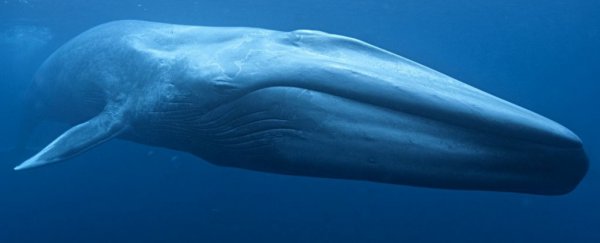New research suggests interspecies hanky panky between blue and fin whales is more common than we thought, at least in certain parts of the world.
Genome sequencing of North Atlantic blue whales (Balaenoptera musculus musculus) revealed around 3.5 percent of the group's DNA came from a neighboring species, fin whales (Balaenoptera physalus).
The scientists from Canada and Norway didn't expect this percentage to be so high. What's more, all the present-day blue whale samples in their study had at least some fin whale DNA in their genome, a phenomenon called introgression.
"Our results provide the first insights into the population structure, and demographic history of blue whales from the North Atlantic, and document levels of introgression with fin whales," data scientist Sushma Jossey from the Royal Ontario Museum and colleagues write in their published paper.
The surprising part is that most hybrid animals (the offspring of two different species) tend to be infertile - you might've heard this about the mule (a hybrid of donkey and horse) or the liger (that's a lion-tiger hybrid).
The parents of infertile hybrids must be similar enough to breed in the first place, but their offspring don't have the suitable genetic material to produce viable sperm or eggs.
However, a 2018 study found whales in the rorqual group, which includes fin and blue whales, have some genetic features that mean hybridization is not a total dead end.
This might be because the species have not split apart on the evolutionary tree so much that their genes are incompatible in the way other infertile hybrids are.
They both have 44 pairs of chromosomes, and an identical chromosomal pattern that shows up in a genetic test called C-banding.
The first example of a fertile cetacean hybrid was caught in Icelandic waters in 1986 - a pregnant hybrid fin / blue whale carrying a fetus fathered by a blue whale. So it's pretty clear how the fin whale DNA wound up in these blue whales.
Interestingly, the interspecies exchange of DNA, known as introgression, appears somewhat one-sided in this case.
While the blue whales have quite a bit of 'fin' in them, previous studies have found that fin whales don't appear to be inheriting blue whale DNA in the same way.
This might mean that blue whales are the only species willing to mate with a hybrid, perhaps because they can't afford to be choosy - the fin whale population is much more substantial in numbers, while the blue whale population is slim pickings.
Their numbers have been precarious ever since technology enabled humans to hunt these speedy giants, which began in the study area in question, the Northern Atlantic, and pushed the species to the edge of extinction. And it's never quite recovered.
So, is there any harm in a bit of cross-species whale love?
In one sense, the ability to breed with other similar whale species means there are more available suitors, which is better than situations in which dwindling numbers lead to inbreeding that can be detrimental for an already struggling species.
But speciation is a pretty important part of genetic diversity too. When the lines between two species get so blurry they're indistinguishable, it's not that different from one of two species going extinct outright.
So far, there's no sign that the fin whale DNA present in blue whales is causing them any problems.
However, Jossey and team are concerned that if blue whale DNA is lost across the population, the species may become less resilient to adapting to environmental changes, especially in a world of human-induced climate change.
"Our sequencing and population structure analyses provide a genomic baseline to inform ongoing conservation strategies for this iconic species," the authors write.
This research has been published in Conservation Genetics.
